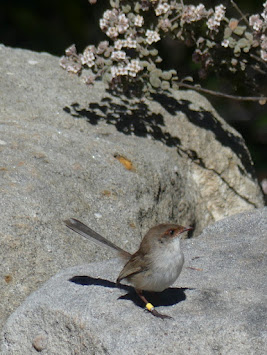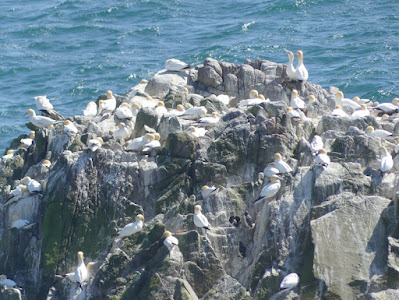You may recall that we're not long back from nearly five weeks in Ireland, where our very enjoyable and educational road trip was an inevitable mix of cultural (including some truly excellent food, coffee and the odd beer or so), historical (relating both to the older 'golden' period of Irish society with its relatively enlightened laws and the darker days of Norman/English invasion and occupation) and of course the natural. I was certainly very interested in the cultural/culinary and older historical aspects, but this blog always focuses on the natural world so it is that on which I'll concentrate. Clearly 5 weeks (or 5 years) will never make me an expert, so I can only relate here what I read and learnt and saw. If I learn more from your reactions to this, so much the better.
One of my first impressions as a visitor with some ecological knowledge,
and too much experience of looking at damaged Australian landscapes, is
that much of what we drove and walked through was a savagely deforested land.
 |
Beara Peninsula, County Kerry. Looking across grasslands that have been grazed by sheep and
cattle for at least 4000 and perhaps 6000 years, from when Neolithic farmers began to arrive from
Britain and to clear the vast forests for farmland. In time they were aided in this by their
use of porcellanite, a hard form of silica which was much more efficient at felling trees than
the older flint axes. It was obtained from only a couple of sites in the north and widely traded,
in Ireland and beyond. |
|
In fact the only extensive landscapes we experienced that probably resembled their original state were some of the high rocky heathlands, though at least some of these were also originally forested.
 |
Heathland above farmland on the edge of Wild Nephrin NP, County Mayo, looking across to
Achill Island. 15,000ha Wild Nephin (formerly Ballycroy NP until 2018) is one of Ireland's
wildest parks and will become more so as an area added recently is 'rewilded' by removing
conifer plantations, planting native trees and protecting the blanket bogs (more on that below). |
 |
| Heathland below An Earagail (or Errigal), Glenveagh NP, County Donegal. |
 |
Killarney NP, County Kerry. I am unable to say how much of this grand landscape is naturally
treeless, but I think I can safely say that trees never grew on the rocky ridges - unless there
was soil that has since washed away. |
Some of the details of what follows are contested, which is how scientific understanding advances, but I'm following what seem to be the majority beliefs, as expressed in park information centres (which are well-resourced and -presented throughout the republic) and in other reading that I've done. This of course doesn't make it 'true', especially in every detail.
None of this is a criticism or a complaint - as an Australian I am in no position to criticise others for poor land management, especially when it began so long ago. Moreover much is being done to redress the issue via 'rewilding' projects. I'm simply commenting that sometimes it was painful to see, as is much of the Australian countryside in more settled areas.
 |
The Ardgroom Stone Circle in County Kerry is some 3000 years old. These circles were
built in situations with views to mountains, and often to loughs or bays.Given this apparent
attention to the views it seems to me that the forest had likely been cleared by then. |
When people arrived in Ireland some 9000 years ago, after the end of the last glaciation, it is estimated that about 80% of the land was covered in forest. (Much of this was temperate rainforest, though it has also been persuasively argued that at least some of it was more open woodland and even grassland.) These Mesolithic people were essentially forest people who lived by hunting and gathering, and they had neither the means nor the desire to clear the forests. The Neolithic people did, as explained above, and that need increased with each subsequent wave of invaders, until by 1600 75% of the forests had gone. When London burnt in the 1660s a lot of the remaining Irish oak forests were cut down to help rebuild it. Ship-building and barrel-making also contributed to the clearing. By 1900 perhaps 1% of the original forests remained. When (most of) Ireland returned to Irish rule as a republic in 1922 this began to turn around with replanting of trees and now 11% of Ireland is forested again.
There is a strong movement on both public and private land towards this 'rewilding' by protection to allow natural regeneration and by active revegetation. That of course means different things to different people, and some restored forests (often referred to as woodland) are obvious near-monoculture plantations, especially of Scots Pines Pinus sylvestris (Ireland's only native pine), though others provide much more complex ecosystems.
 |
Scots Pine plantations in Dooney Rock Forest, County Sligo above,
and The Raven Nature Reserve, County Wexford, below. |
 |
Such plantations are by no means devoid of life; here we saw a good array of birds,
including Great Spotted Woodpeckers which have recently colonised (or perhaps
recolonised) Ireland, and the only Red Squirrels we saw. |
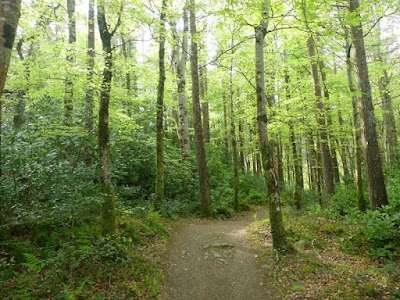 |
Beech forest Fagus sylvatica, Ards Forest Park, County Donegal; Beech is not native
to Ireland but has been widely planted since the 1700s. Ards Forest is mostly planted
but is diverse with regard to trees and the understorey. It is managed by Coillte, a
'state-owned commercial forestry business' which manages more than half of Ireland's
forests. Its claim is a commitment to managing 20% of its estate to prioritise biodiversity
but the reality of this has been regularly challenged, as has its practice of clear-felling,
which is banned in parts of Europe. However Ards Forest, at least on our visit there,
looked relatively pretty good, though I'm not in a position to comment more usefully
on this issue. |
 |
| Beech leaves, Ards Forest Park. |
The famed Killarney National Park in County Kerry, with 1200 hectares of oak forest, represents the largest area of native forest left in Ireland, though not all of it is undisturbed.
 |
Along the short walk to Torc Falls in Killarney National Park, through the oak forest;
this is a very heavily visited area, but the tracks are in good condition to support the foot traffic. | |
 |
| Torc Falls. |
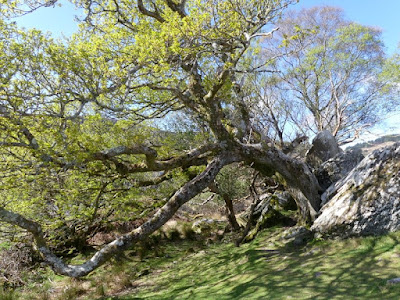 |
Old Sessile Oak Quercus petraea, Killarney NP, Ireland's national tree.
This particular tree is one of several growing in exposed conditions around a carpark
at a lookout on the western approach to the park through the mountains; it's not clear if these
were always outliers on the upper edge of the forest, or are survivors of forest clearing. |
The only forest with seemingly unequivocally original elements that we visited was Glengarriff Nature Reserve at the foot of the Caha Range in County Cork and even here ancient oaks were apparently felled to plant pines in the 1950s, before the remaining 300ha were preserved in 1991. The short walk we did there was awesome - and I save that word for when something really does inspire awe in me!
 |
| Wet Sessile Oak forest - rainforest in fact - Glengarriff NR. |
The blanket bogs mentioned earlier are synonymous with western Ireland, which contains some of the largest areas of active (ie still peat-producing) blanket bogs in Europe. I mentioned Wild Nephin NP in County Mayo earlier; it protects one of the last intact active bogs in Europe. The origin of the blanket bogs is a vexed topic and there's no point me taking a stance here. Some claim that the blanket bogs are purely a human construct and that they only formed 4000 years ago when forest clearing began and land became waterlogged. Others assert that they began to form 10,000 years ago after the last glaciation; either way it certainly makes sense that the area of bog would have increased from 4000 years ago. Large quantities of logs and stumps are hidden in the bogs, and were extracted for use in earlier times, implying that at least some of the bogs are on formerly forested land. It is not contested however that they are important habitats and in need of protection. (I've spelt out blanket bogs each time because there are also raised bogs in the central mountains, which no-one seems to dispute are natural. They are deeper and smaller, not extending across the landscape like blanket bogs.)
 |
| Blanket Bog, Wild Nephin NP. |
 |
Bog Cotton or Cottongrass Eriophorum angustifolium is actually a sedge,
and is one of the signature plants of the bogs. Here at Wild Nephin NP. |
Before concluding this very abbreviated introduction to Irish habitats with an inevitable nod to the waters of the island, I want to briefly introduce one small but remarkable area of specialised habitat from County Clare on the west coast. This is The Burren, an area of deeply fissured sheet limestone that covers the surface of the land from the hinterland down to the sea; the plants that it supports, in addition to the typical Irish flora, contains elements of flora of the Mediterranean, the Arctic and the European Alps, including a stunning blue gentian which was unfortunately not flowering when we were there.
 |
The Burren NP in Clare; it a was a wet very Irish day when we were there, and we didn't stay as
long as we might otherwise have done. |
 |
| The Burren kaarst landscape extends to the sea near Ballyvaughan. |
At the end of the post I'll feature some flowering plants that we saw, and several of them were in The Burren, including the only orchid species we saw.
And of course Ireland is wet! Part of this wetness is in the form of valuable wetlands, including a couple of very important ones in County Wexford in the south-east. The Wexford Wildfowl Reserve has a couple of features that might make us raise our eyebrows in Australia, but it is an important winter sanctuary for many species of waterbirds that nest in the Arctic, especially the Greenland White-fronted Geese, of which the reserve harbours a third of the world population. Firstly much of it is farmland, and secondly 'the Slobs' were 'reclaimed from' the sea, or stolen from it, depending on your perspective, back in the 1840s by walling off a section of Wexford Harbour; much of the Slobs are about two metres below sea level.
 |
| One of the Wexford Wildfowl Reserve's Slob ponds. |
However a much larger Wexford wetland, of some 500 hectares, is Tacumshin, a natural coastal lagoon declared a Special Protection Area (SPA) under the EU Birds Directive. It is regarded by the National Parks and Wildlife Service as
'as one of the most important ornithological sites' in Ireland, but as far as I can tell it has no formal protection under Irish law. We spent a pleasant and rewarding afternoon there.
 |
Two views of the Tacumshin Lagoon, with some of the waterbirds (especially
Mute Swans) visible below, albeit distantly. |
Unsurprisingly the countryside, especially where it's hilly, is dotted with loughs (the Irish form of the Scottish loch - or vice versa of course). Good habitat and very good scenery!
 |
The Isle of Innisfree - made famous by poet William Butler Yates, a Sligo local -
in Lough Gill, County Sligo. |
 |
Lough Nagarnaman, just below our very remote little cabin,
high in the mountains of County Donegal. |
 |
A small section of Lake (not Lough for some reason) Muckross
in Killarney NP, County Kerry. |
And lastly with regard to Irish landscapes are the seascapes, which are pretty grand all along the Atlantic coasts in particular (ie south, west and north). I kept a careful lookout for cliffs, as seabird breeding sites, but after a spectacular start on Great Saltee Island off Wexford, we either couldn't get close enough to other cliffs or the weather made observations difficult. It didn't stop us enjoying the scenery though of course!
 |
These and other cliffs on Great Saltee had breeding Gannets, Puffins, Guillemots,
Razorbills, Fulmars, Shags, Kittiwakes and other gulls among others.
I'll introduce some of them in the next post. |
 |
| The famous Cliffs of Moher, in County Clare, seen through rain blown horizontally! |
 |
The west coast of Achill Island in County Mayo was another cliffscape that attracted us.
None of these cliff examples were very high by Australian standards but were impressive nonetheless. |
There were rocky headlands with associated beaches...
 |
| Near Cleggan, County Galway. |
 |
| By Fanad Lighthouse, County Donegal. |
 |
| Beara Peninsula, County Kerry. Glorious coastline, sadly treeless hinterland. |
... and of course islands, but none of them more impressive than the Skelligs.
 |
Skellig Michael and Little Skellig, 13k off the Iveragh Peninsula, County Kerry.
Skellig Michael is on the UNESCO World Heritage List for its 6th century monastery.
The island featured in one of the Star Wars series, but it is less well-known that approval
for the filming was granted by a government minister without proper consultation and
allowed during breeding season, when Kittiwake chicks were blown from their nests
by a helicopter down-draught, to drown and be eaten by larger gulls.
In the foreground is a deserted farmhouse (likely to have been abandoned during
the famine years of the mid-19th century) and stone walls marking the boundaries
of small fields. |
And I'm going to end this post with some flowering plants that we enjoyed in various of these landscapes. We were there in April, which is very early spring, so while there was certainly plenty of colour, there weren't nearly as many species flowering as there would have been later. One thing that took some getting used to was seeing plants we know as weeds, growing in their natural setting. Gorse, Dandelions and Hawthorn are all native plants here! Pretty much everything else was new to us, so we weren't discriminating and most of what follows will be somewhat ho-hum to any European readers.
 |
Gorse Ulex europaeus, Wild Nephin NP, County Mayo. Much of the country
was golden with Gorse during our travels. |
The rest are pretty randomly presented.
 |
Wild Leek (and many other names) Allium ursinum, Family Amaryllidaceae,
Dooney Rock Forest, County Sligo. This edible plant is widespread in Europe and Asia,
and has long been used as a vegetable or salad green. |
 |
Three-cornered Leek Allium triquetrum. Actually I've just discovered that this
one, a Mediterranean species, has been introduced to Ireland, perhaps because
it too is edible and is used like spring onions. |
 |
Wood Anemone A. nemorosa, The Burren NP, County Clare.
This is one of the first wildflowers to appear in spring. |
 |
Thrift Armerica maritima Family Plumbaginaceae, Fanad Lighthouse, Donegal Ireland.
This lovely flower is found in large clumps on coastal rocks and in salt marshes. |
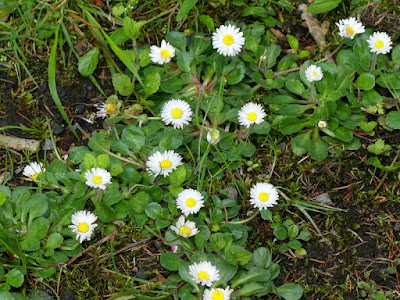 |
Daisy Bellis perennis Family Asteraceae, Belleek Woods, County Mayo.
And yes, it is referred to as just 'the daisy', as it is so ubiquitous! |
 |
| Lady's Smock Cardamine pratensis Family Brassicaceae, Drombeg Stone Circle, County Cork. |
 |
Common Scurvy-grass Cochlearia officinalis, Family Brassicaceae, near Cleggan,
County Galway. This member of the cabbage family has nothing to do with grass,
and grows, like Thrift above, on sea cliffs and rocks, and in salt marshes. |
 |
Holly Ilex aquifolium, Family Aquifoliaceae, The Burren, County Clare.
The famous Holly grows mostly as an understorey tree in deciduous forests, but
was here growing as a low shrub in the limestone heathland of the The Burren. |
 |
Bluebell Hyacinthoides non-scripta Family Asparagaceae, Belleek Woods, County Mayo.
Bluebells were just coming into flower while we were there and they were ubiquitous!
And always a delight... |
 |
Wood-sorrel Oxalis acetosella, Family Oxalidaceae, Glengarriff NR, County Cork.
Wood-sorrel is found across much of Europe and western Asia, wherever it's damp and shady.
It is sometimes known as shamrock for its trifoliate leaves, but the true Shamrock is a clover. |
 |
Cowslip Primula veris, Family Primulaceae, The Burren NP, County Clare.
I'd come across Cowslips in novels and poetry, but had no idea what they looked like.
Now I know. |
 |
Primrose Primula vulgaris, Glengarriff NR, County Cork.
The same comment applies here as for Cowslips above. They were coming
into flower in many places that we went, and are nicely scented. |
 |
Strawberry Tree Arbutus unedo, Family Ericaceae, near Kenmare, County Kerry. Though widely
planted, this member of the heather family is found naturally only in and adjacent to
County Kerry, and around the Mediterranean! In Ireland it grows as an understorey tree
in wet forests, such as the remnant oak forests of Glengarriff NR. | |
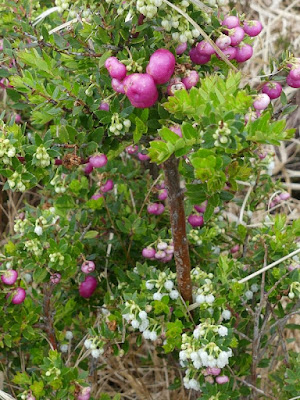 |
Bilberry Vaccinium myrtillus, Family Ericaceae, Wild Nephin NP, County Mayo.
This edible-berried plant grows in boggy heaths across northern Europe, Asia
and North America. |
 |
Dog Violet Viola riviniana, Family Violaceae, Drombeg Stone Circle, County Cork.
It is described as the commonest Irish violet and we found it to be so in many places. |
And those who know me will not be surprised that I'm ending this brief
round-up of common Irish wildflowers with an orchid, though it nearly
didn't happen. We only found only one species that had started flowering,
and that only in one site, the wonderful Burren - in the rain!
 |
Early Purple Orchid Orchis mascula, The Burren NP, County Clare. This lovely orchid,
which I failed to do justice to here, is found throughout Europe almost up to the Arctic,
and across North Africa and to Iraq. But it was new to us! |
If you've persevered to here, I'm grateful (and impressed). If so you
might like to come back next time, when I finish this Irish journey with
some animals, and especially birds.
NEXT POSTING THURSDAY 17 JULY
I
love to receive your comments and in future will be notifying you
personally by email when a new posting appears, if you'd like me to. All
current subscribers have been added to this mailing list and have
already been contacted. This will mean one email every three weeks at the current rate of posting. I promise never to use the list for any other purpose and will never share it.
Should you wish to be added to it, just send me an email at calochilus51@internode.on.net. You can ask to be removed from the list at any time,or could simply mark an email as Spam, so you won't see future ones.
If you do leave a comment - and I love it when you do - please remember to click the
box below your comment that says 'Email follow-up comments to...[your address]'
so you'll know when I reply - and I always do!





















































